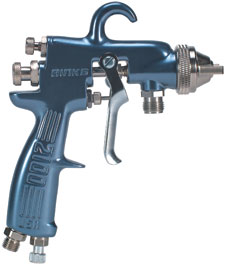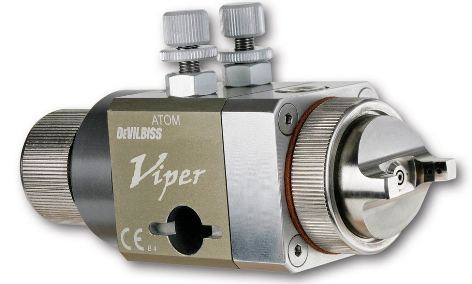Binks & DeVilbiss: Unbeatable in ceramics & sanitary ware
Contents
Spray guns for glazing: From 2100V to Viper
In the year 1892 Joseph Binks built the first cold water paint spray machine to whitewash the companies large sub-basements. And only one year later this invention rescued the opening of the 1893 Columbian Exposition in a spectacular action: Painters for the 1893 Chicago Columbian Exposition could not keep pace to finish the construction and used the Binks paint spraying machine to whitewash everything on time.
Over the last decades Binks introduced several ground-breaking manual and automatic spray guns: In the year 1934 Binks introduced its popular Model 7 spray gun which has been used in every conceivable application since then. The legendary conventional spray guns Model 630, 2001V (and successor 2100V) 95A, AGN are still very popular today and still widely used for spray glazing of sanitary ware and ceramic products, even in industrial-scale production. One of the reasons: Most needles and nozzles are also available in tungsten carbide which can much better withstand the abrasiveness of the glaze material.

Binks 2100V spray gun (with tungsten carbide nozzle & needle)
The tough environment of spray glazing
The high-humidity spray environment is corrosive and the abrasiveness of glaze can accelerate equipment wear. Ceramic glazes are inorganic coatings which also consists of silicate particles (hydrated magnesium silicate) and flint, a very hard sedimentary rock composed mainly of silica. Flint is such a hard material that prehistoric people made tools and weapons out of it. The silicate and silica materials are highly abrasive and can cause excessive wear on normal stainless steel needles and nozzles.
Viper automatic spray gun: Dismantlement without tools
DeVilbiss introduced a completely new design of spray gun, purpose made for the tough working conditions in the glaze & ceramics industries, i.e. very suitable for sanitaryware, tableware, ceramic floor and wall tiles, ceramic cookware and applying vitreous enamel to many household electrical appliances like washers, dryers, stove tops and hot water heaters.

Devilbiss Viper automatic spray gun (picture: Finishingbrands)
The patented “Quick’Up” system (instant ¼ turn air cap and fluid tip removal) allows easy and fast disassembly of the air cap and fluid tip which significantly reduces production downtime. Moreover, all working parts of the gun can be completely disassembled in seconds without the use of tools.
The new so-called “Bellow” system, also patented, protects the needle and needle packing which extends the operating life cycle of the spray gun. Spray performance and fluid flow can be controlled by means of a fluid adjusting knob with 18 indexing positions.
And like a must for all “glazing spray guns” of DeVilbiss (and Binks), fluid tips and needles made from tungsten carbide are also available.